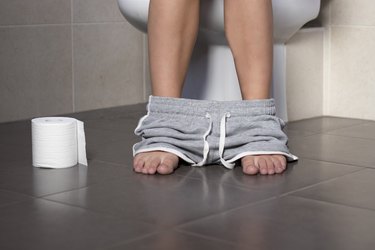
The hottest accessory in the bathroom is...a toilet stool! No, really — and if you have certain types of poop problems, it can really help.
Here's who should consider investing in a bathroom stool and what research says about how well they actually work.
Video of the Day
Video of the Day
Who Should Get a Toilet Stool?
Toilet stools like the Squatty Potty are useful if you go to the bathroom and feel like you can't get everything out. (This process is what GI experts refer to as "evacuation.")
"You'd be surprised how many people struggle with difficulty having bowel movements related to the evacuation process," says Justin Maykel, MD, Chief, Division of Colon and Rectal Surgery at UMass Memorial Medical Center. "For whatever reason, the muscles in the pelvic floor become uncoordinated. Instead of relaxing and allowing for the evacuation of stool to happen in a normal fashion, the whole process gets thrown off."
What usually happens is that the anal sphincter muscle is contracted when you're sitting at your desk, walking around or just Netflix binging. That's great! Those are all times you don't want to poop.
The automatic contraction means the anal sphincter stays closed and keeps stool in. But when you sit down to go and give a little push, the muscles relax, Dr. Maykel explains, allowing the rectum to straighten and stools fall out with a combination of pushing and gravity. In some (very frustrating) situations, though, the process is not coordinated and muscles contract rather than relax during pushing.
Enter the toilet stool — a low stool placed at the base of the toilet. You use it by placing your feet on top as you're sitting on the toilet seat.
"This allows your feet to be at a higher level, which straightens out the angle of the rectum, making it easier to go," says Jacqueline Wolf, MD, a gastroenterologist at Beth Israel Deaconess Medical Center in Boston and author of A Woman's Guide to a Healthy Stomach.
It's worth noting that before the modern toilet, squatting was the normal poop position, and our newer way of sitting to have BMs may contribute to poop problems, researchers say in a 2019 issue of the Journal of Education and Health Promotion. Indeed, the hip flexion when squatting compared to sitting has been found to lessen the strain required to poop. And bonus: Spending less time on the toilet could possibly reduce the risk of hemorrhoids.
So, Do They Work?
Believe it or not, there's some research on toilet stools. In a study on 52 young people (and 1,119 of their bowel movements), using a toilet stool helped empty bowels, lessened straining and decreased the time spent on the toilet compared to not using one, according to a March 2019 paper in the Journal of Clinical Gastroenterology.
Still, toilet stools can only do so much.
"They won't necessarily fix the problem entirely. However, it certainly allows for more effortless and comfortable bowel movements if someone is straining a lot," says Niket Sonpal, MD, an internist and gastroenterologist in New York City.
Still, they're not risky to use, so you can give them a try without worry, he says. (If you are physically able, you can also lift your knees up in this position while on the toilet, getting yourself into position without needing a stool to do so. It requires a bit of balance, but many people will find they can do this just fine.)
If you can easily have a BM, you don't need a toilet stool, Dr. Wolf says. Similarly, using one can't overcome poor GI health habits, like skimping on fiber or not drinking enough water throughout the day. "If you have constipation, increase fiber and fluid first," she says.
If you feel like not everything comes out when you go number two, then make an appointment with a doctor to be evaluated.
"A good physical exam will check for proper relaxation of the anus and position of the rectum when you're trying to have a BM," Dr. Wolf says. Additional tests to see how the rectum and anal sphincter are functioning may be needed.
What to Look for in a Toilet Stool
When buying a stool, the most important feature is that the height should be right for you, Dr. Wolf says. That's about six inches, but it differs depending on how tall you are.
If you're tall and your stool is too short, your feet won't be elevated enough to make a difference, she adds. And if you're short and the stool is too tall, it may not be comfortable.
Make sure the height is right for you before buying. The Squatty Potty brand has a Bamboo Flip Toilet Stool ($39.99) with a base you can flip to alter the height. One side is 7 inches high and the other is 9 inches.
There's also the Squatty Potty Adjustable Toilet Stool ($29.99), a fuss-free plastic model that also adjusts between 7 and 9 inches. That can help you find the most comfortable position, but it also can accommodate other people in your household.
- Lower Urinary Tract Symptoms: “Influence of Body Position on Defecation in Humans”
- Journal of Education and Health Promotion: “Health promotion and prevention of bowel disorders through toilet designs: A myth or reality?
- Clinical Gastroenterology and Hepatology: “Rethinking What We Know About Hemorrhoids”
- Journal of Clinical Gastroenterology: “Implementation of a Defecation Posture Modification Device”
Was this article helpful?
150 Characters Max
0/150
Thank you for sharing!
Thank you for your feedback!
Is this an emergency? If you are experiencing serious medical symptoms, please see the National Library of Medicine’s list of signs you need emergency medical attention or call 911.